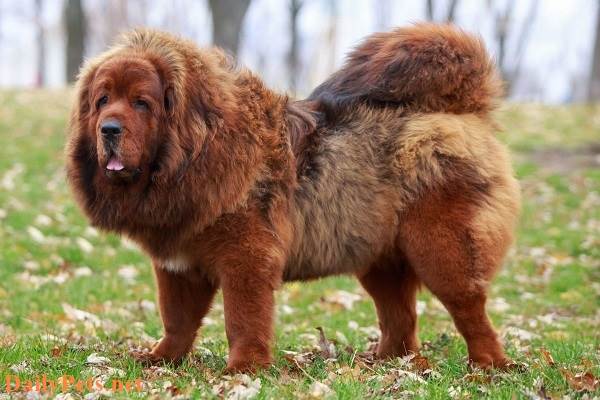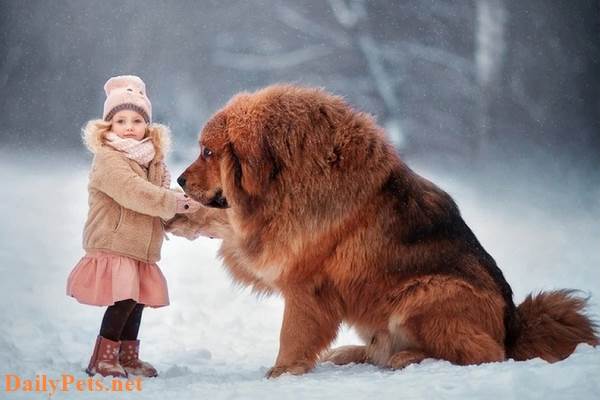Let’s explore more about this Tibetan Mastiff breed with DailyPets.net!
Origin of Tibetan Mastiff Dogs
Tibetan Mastiffs originate from the Tibetan plateau in China and are known for their massive size. This breed has preserved its primitive genetic makeup and has hardly interbred with any other dog breed.

Tibetan Mastiff Dog.
They were introduced to Europe in the 19th century and viewed as rare and precious gifts for royalty and queens. Today, the fame of Tibetan Mastiffs has spread to countries in the Americas, such as the United States and Canada. However, due to their popularity and high cost, this breed has undergone various crossbreeding and commercialization. Purebred Tibetan Mastiffs can now mostly be found in the highlands of Tibet.
Common Coat Colors of Tibetan Mastiff Dogs
These giant dogs have a thick double coat covering their entire body like armor. Their coat colors are not diverse, primarily black, yellow, red, gray, and brown.
Physical Characteristics of Tibetan Mastiff Dogs
The most remarkable feature of Tibetan Mastiffs is their large size, standing at about 70-80cm (27-31 inches) tall and weighing between 60-90kg (132-198 pounds). Their dense fur makes them even more “gigantic.” Their shaggy coat has a two-layer structure, with a soft and short inner layer and a longer, coarser outer layer. This woolly coat helps them adapt to the coldest weather conditions.

Underneath that massive coat is a robust and balanced body. Their large legs are the strongest part of their physique, allowing them to stand firmly, anchor to the ground, and even outrun wolves. Their chest, shoulders, and hips are also well-developed. The Tibetan Mastiff’s body can be described with the phrase, “larger than a wolf, stronger than a tiger, and faster than a deer.”
These dogs have large heads, broad faces, wide mouths with sharp teeth, and small, slightly slanted eyes that give them a fierce and formidable appearance.
Personality Traits of Tibetan Mastiff Dogs
Tibetan Mastiffs are known for their unwavering loyalty. They will remain faithful to the person who has cared for and raised them since they were puppies, acknowledging only this individual as their master. They are ready to fight and sacrifice themselves to protect their owner.
Due to their wild nature, Tibetan Mastiffs can be quite aggressive and extremely dangerous. These giant dogs, along with Pitbulls, are considered the two most dangerous dog breeds in the world. Their aggressive temperament, agility, and immense strength can make them a threat if not properly trained.
However, despite their dangerous nature, they are obedient to their owner, gentle, and friendly when living with them.
Caring for Tibetan Mastiff Dogs
Diet for Tibetan Mastiff Dogs
To ensure the best development of Tibetan Mastiffs, you must provide them with a balanced diet rich in vitamins, minerals, and a high amount of protein and calcium.
Dietary Requirements for Tibetan Mastiff Dogs by Age:
- For Tibetan Mastiff puppies aged 2-4 months, feed them rice with finely ground lean meat, supplemented with other dog foods, three times a day.
- For Tibetan Mastiffs aged 4-8 months, you should increase the protein intake through meats such as beef, lean pork, animal organs, chicken necks, and duck. You can also include eggs, vegetables, and dry dog food.
- You can also give them large bones, such as beef legs and pig bones, to strengthen their jaw and provide calcium. However, be cautious with sharp bones like chicken and duck bones to avoid throat damage.
- At this stage, you can reduce their meals to two times a day and increase the portion size.
- For Tibetan Mastiffs over 8 months old they need a minimum of 1 kg of food per day. Supplement their diet with dry food, fruits, and vegetables for easier digestion. Adjust the food quantity according to their weight.
Grooming for Tibetan Mastiff Dogs
Tibetan Mastiffs have origins in Tibet, and they are accustomed to cold temperatures. Therefore, it’s important to provide them with ample space to run and play, along with access to shade in hot and humid weather. If the weather is hot and humid, it’s advisable to keep them in air-conditioned rooms.
Regular grooming is essential to manage their thick fur, especially during the summer. Their dense coat should be brushed daily to keep it smooth and tangle-free. A wide-toothed comb is recommended due to their thick fur.
Bathing should be done at least once a month to maintain hygiene. After bathing, use a dryer or allow their fur to air dry to prevent dampness, which can harbor bacteria and cause fungal skin infections. Additionally, it’s important to regularly clean their facial folds, ears, and toe spaces to prevent parasite infestations.
Common Health Issues in Tibetan Mastiff Dogs
Despite their robust physique and enormous size, Tibetan Mastiffs can still suffer from certain health issues:
- Brachycephalic Obstructive Airway Syndrome: This condition is common in large dog breeds with broad faces. It may be caused by genetics, calcium deficiency, or overexertion, leading to loose jawbone joints and an abnormal gait.
- Infectious Tracheobronchitis: Young puppies are prone to this condition if not kept warm properly. Symptoms include red and inflamed eyes, dry nose, and prolonged coughing. Early treatment is crucial to prevent chronic illness.
- Gastrointestinal Problems: Gastrointestinal issues can result from improper diet or insufficient deworming. Common symptoms include loss of appetite, vomiting, and high fever.
Tibetan Mastiff Prices
Nowadays, Tibetan Mastiffs are bred in various places around the world, but their numbers as pets are limited due to their relatively high cost and partly due to their aggressive nature. A two-month-old Tibetan Mastiff typically has an average price range of around $500 to $1000. As they grow older, the prices for these dogs also increase.
Imported Tibetan Mastiffs, especially those from Europe or America, can be extremely expensive, ranging from $8000 to $10000.
A purebred Tibetan Mastiff imported from Tibet can command a price as high as $500,000 or even $1,000,000. You heard that right; with their primitive genetics, enormous size, attractive appearance, and limited availability, Tibetan Mastiffs from Tibet can be that costly, and not everyone can afford them.
Things to Consider When Buying a Tibetan Mastiff
Tibetan Mastiffs are a special breed, and there are some key points to keep in mind before purchasing one:
- Assess your budget: Before shopping, consider what kind of Tibetan Mastiff you can afford. This will help you be more proactive in your buying decisions.
- Avoid buying a cheap Tibetan Mastiff: Don’t trust places selling them at low prices, as they might not be genuine Tibetan Mastiffs.
- Don’t follow trends: Many people choose to own Tibetan Mastiffs just to follow trends or show off their wealth. This is a serious mistake. Tibetan Mastiffs are not like other pet dogs; they are aggressive and can be dangerous if not raised and trained properly.
- Buy from reputable sources: To ensure you get a genuine Tibetan Mastiff at a fair price, look for reputable sources with clearly stated prices.
Hopefully, this information about Tibetan Mastiffs from DailyPets.net will help you better understand one of the most expensive and dangerous dog breeds in the world.





